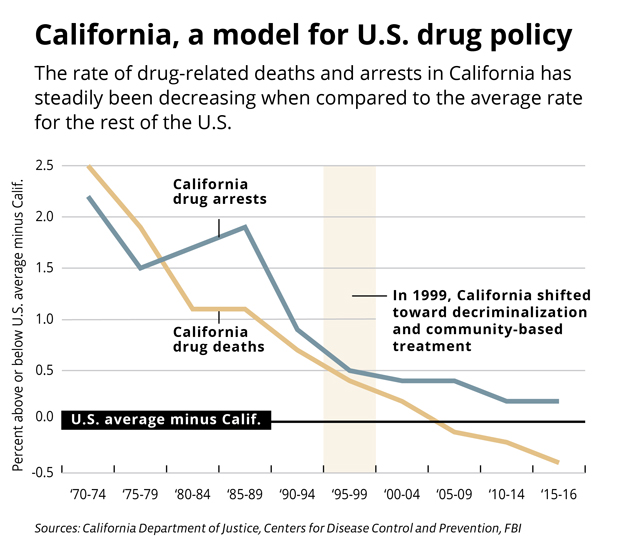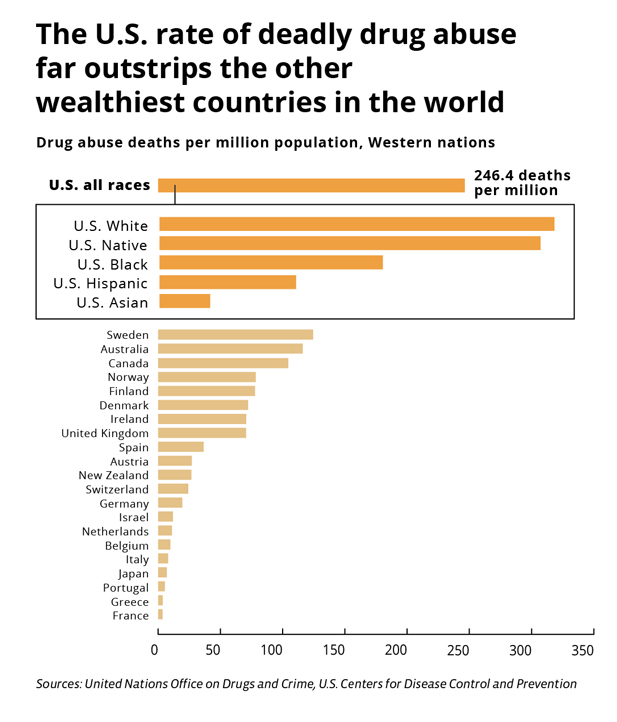Trump’s War on Opioids Won’t Work—But California Knows What Will

The U.S. rate of deadly drug abuse is 7.5 times higher than that of the 24 other wealthiest countries in the world.
Photo by John Moore / Getty Images.
When it comes to drug abuse, there’s the United States. Then there’s the rest of the world.
The U.S. rate of deadly drug abuse is 7.5 times higher than that of the 24 other wealthiest countries in the world, accounting for four-fifths of all drug deaths among developed nations.
Last week, President Donald Trump belatedly acknowledged the “worst drug crisis in American history.” His “emergency declaration” amounted to little more than bluster, however, stopping short of declaring a national emergency that would free up significantly more federal funding. Meanwhile, the war on drugs continues apace: Another 1.5 million people were arrested in 2016 for drug-related crimes; 300,000 people remain in state and federal prisons on drug offenses; and Attorney General Jeff Sessions has been chomping at the bit for an escalation of the drug war.
We need urgent answers, but one of the questions that’s not being addressed in the current crisis is this: Why does the United States suffer out-of-control epidemics massively endangering Americans and feeding violent global drug networks that serve our habits, while other countries have been better able to control them?
America’s 35-year war on drugs has expended over $1 trillion.
Other countries also have aging citizens with physical and mental health pains requiring treatment, pharmaceutical industries, and unemployment, and yet the United States is the outlier in being unable to get hold of the problem.
The U.S. ranks worst by far among all 88 nations for which the United Nations Office on Drugs and Crime produces reliable drug death figures. We represent only 14 percent of all 88 nations’ populations ages 15-64 but account for 59 percent of all drug deaths, a level nearly nine times higher than in other countries.
This grim “American exceptionalism” is getting worse. Provisional 2016 figures from the Centers for Disease Control show a record 21 percent leap in drug deaths to over 65,000 in the latest 12 months.
Republican and Democratic administrations have followed patently ineffective drug policies whose stated goals were to punish recreational drug users while neglecting the urgent issue of addiction and abuse. The first Reagan-era National Drug Control Strategy declared war on casual drug use because its “highly contagious” example encourages new users and defiance of authority. Meanwhile, addicts were “the worst possible advertisement for new drug use,” an example to leave on public display to discourage others from drug use, even while many administrations paid little more than lip service to treatment programs.
This “harm maximization” concept has governed drug policy ever since, led by politicized initiatives like the White House Office of National Drug Control Policy, the National Center on Addiction and Substance Abuse, and the Partnership for Drug-Free Kids. The results of their dominance over drug policy have been calamitous.
America’s 35-year war on drugs has expended over $1 trillion, arrested over 50 million people, incarcerated tens of millions, and spent billions on anti-drug ads in the largest, most sustained, most punitive anti-drug campaign any society has ever waged.
As the drug war escalated, the worst manifestation of drug abuse, deaths from illicit-drug overdoses, skyrocketed from 8,000 in 1980 to 65,000 in 2016.
The highest and fastest-rising rates of alcohol deaths (as for drug deaths) are among middle-aged Native, White, and Black populations.
That trend has long been obvious. As far back as 1992, as politicians, police, and media reporters demonized inner-city crack-cocaine users, pharmaceuticals caused half of the rising toll of illicit-drug deaths and “White adults over age 25 comprised two-thirds of all drug deaths but just one-third of all drug arrests.” Despite that figure, most media and political attention—and harsh policing—was focused on the smaller crack epidemic that disproportionately affected Black neighborhoods.
Today, Whites ages 25 and older constitute nearly three-fourths of the hugely increased drug death toll, according to the CDC. Tunes are changing. Older White drug abusers are “victims” meriting treatment and policy reform, not imprisonment.
America’s official policies have proven catastrophic, exploiting Americans’ destructive double standard splitting “deserving, innocent” populations from “undeserving, menacing” ones. A “powerful theme in the American perception of drugs,” the late professor David Musto of the Child Study Center at Yale University wrote in 1991, is the “linkage between a drug and a feared or rejected group within society.”
In this worldview, “acceptable” drugs like alcohol used by “respectable” populations like older Whites are defined as benign. This raises another disturbing secret: In addition to the 55,400 Americans killed by illegal-drug overdoses in 2015, alcohol overdoses killed another 33,200—72 percent of them non-Hispanic Whites. The highest and fastest-rising rates of alcohol deaths (as for drug deaths) are among middle-aged Native, White, and Black populations.

The vast dimensions of America’s addiction crisis have been ignored and distorted for so long that designing workable policies at this late date seems beyond official capability, much less in the Trump era. But there have been some hopeful developments in California, a state that has occupied both extremes of the drug crisis.
In the 1960s and ’70s, California’s rates of drug arrests and deaths from illicit drugs were staggering, double to triple the national average. By 2016, the state’s rate of drug arrests had fallen to only slightly above the national average and its rate of drug deaths had fallen to 40 percent below that level.
The opioid crisis is dividing the problem-solvers from the problem-exploiters.
In between, in the 1980s and ’90s, California led the drug war, arresting some 4.7 million people for drug offenses, one-fifth the national total. By 1998, California imprisoned 40 times more people for drugs than in 1980. However, evidence mounted that get-tough policing only worsened drug abuse. Courts were mandating against prison overcrowding. In 1999, California shifted away from arrest and incarceration and toward decriminalization and community-based treatment. Imprisonments for drug offenses plunged 90 percent through 2015.
While California displays the best trends of any state in deaths from illicit drugs, there’s a big generational catch: Californians ages 45 and older die from and get arrested for illicit drugs at much higher rates, and younger Californians at much lower rates, than their respective counterparts elsewhere, according to FBI and CDC data.

Younger Californians are composed of higher Latino and Asian populations with high proportions of recent immigrants. California teenagers in particular—now allowed decriminalized access to marijuana the same as adults—show sharply lower crime, drug offenses, violence, shootings, suicides, school dropout, and unwanted pregnancy rates than before drug policy reforms.
The opioid crisis is dividing the problem-solvers from the problem-exploiters. Those exploiting the crisis are pushing the same old rhetorical campaigns and policing crackdowns targeting immigrants, young people, and urban minorities. This in spite of the fact that just 8 percent of America’s drug deaths involve persons under age 25, and 20 percent are people of color. Blaming scapegoats is the only thing drug warriors know to do, a major reason America suffers endless, worsening drug crises.
In contrast, the problem-solvers face a difficult challenge. Questioning why the U.S. suffers such extreme social epidemics raises complex, uncomfortable issues: The persistence of extreme poverty afflicting African and Native Americans; the self-segregation of older White populations into angrier, resentful, self-destructive enclaves; the exacerbation of crises by privatized political and medical interests that profit from addiction; the dereliction of leaders who exploit racial and generational divisions instead of identifying problems and solutions; and the dismaying lack of empathy that bitterly divided Americans display for one another.
Unfortunately, we’re not at the stage where leaders can say the obvious: Let’s study younger people in diverse, reform-minded states with heavy immigration like California to see why their drug death levels are so low. That would be a terrific start.

|
Mike Males
is a senior researcher for the Center on Juvenile and Criminal Justice, the principal investigator for YouthFacts, and the author of five books on American youth.
|


